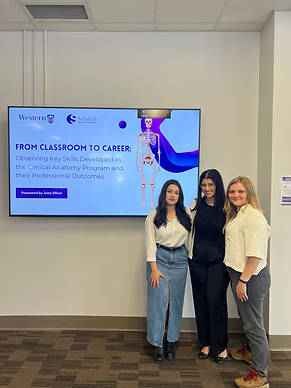
Basic Science Rotation

This rotation provided invaluable qualitative research experience, allowing us to explore how specific skills and experiences gained through the Master of Clinical Anatomy program have shaped alumni career trajectories and achievements. By understanding how alumni feel the program has served them, we gained critical insights into its impact on their professional growth. These findings will help inform recommendations for refining and shaping the curriculum, ensuring its continued relevance and effectiveness in meeting the evolving needs of future students.

Meet Our Supervisor

Dr. Michele Barbeau
Assistant Professor
Ph.D. Western University
Office: Medical Sciences Building, 491
Phone: 519-661-2111 Ext. 86756
Email: michele.barbeau@schulich.uwo.ca
Research Interest(s):
Her research interests lie in the areas of both educational scholarship and clinically related anatomical research. The educational scholarship is focused mainly on developing and assessing methods to enhance the online learning environment for students. Clinical anatomy research focuses on collaborations with other groups to solve anatomically based clinical questions.
Rotation Timeline
December, 2024
November, 2024
October, 2024
September, 2024
-
December marked the conclusion of our rotation, with the primary deliverable—the database—having been completed earlier in the term.
-
As a group, we collectively decided to continue collaborating with Dr. Barbeau to further advance the study beyond the rotation period.
-
We delivered a final presentation summarizing our work and progress, which showcased our findings and ongoing plans.
-
The PDF of the final presentation is available here for further insights into the project.
-
In November, we completed the observerships, finalizing our understanding of the instructional roles within the Master of Clinical Anatomy program.
-
The survey and database were refined, focusing on program alumni who constituted our study population and would be asked to complete the survey.
-
Work began on preparing the ethics submission and developing a comprehensive study protocol.
-
These steps were critical to ensuring the study's alignment with ethical guidelines and its readiness for implementation.
-
In October, we completed observerships with students from the Master of Clinical Anatomy program, focusing on their instructional roles.
-
We observed them teaching anatomy courses to undergraduate students and students from professional schools, gaining insights into their methods and approaches.
-
The functional components of the study, such as the survey, were initiated and began to take shape.
-
Observership notes were meticulously documented to form a strong foundation for the survey's design and content.
-
The month began with introductions to the program, faculty, and peers, fostering a welcoming and collaborative environment
-
We explored the project scope, objectives, and expectations, laying the groundwork for a productive and meaningful rotation experience.
-
Observerships were planned to align with the program's goals, ensuring we gained exposure to skills and techniques relevant to the Master of Clinical Anatomy program.
-
The scheduling emphasized observing hands-on skills and practices directly applicable to the program's learning outcomes.

